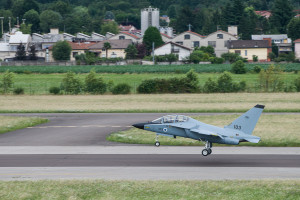Grupo LATAM Airlines divulga estatísticas operacionais preliminares de junho de 2014
July 10, 2014
São Paulo, 8 de julho de 2014.– O Grupo LATAM Airlines S.A. e suas filiais (“Grupo LATAM Airlines” ou “a Companhia”) (NYSE: LFL / IPSA: LAN / Bovespa: LATM33), grupo de companhias aéreas líder em transporte de passageiros e carga na América Latina, informa suas estatísticas preliminares de tráfego para junho de 2014, incluindo o comparativo com o mesmo mês de 2013.
O tráfego de passageiros aumentou 1,1%, enquanto a capacidade diminuiu em 1,1%. Como resultado, o load factor da Companhia para o mês cresceu 1,8 pontos percentuais, alcançando 81,9%. O tráfego internacional de passageiros representou aproximadamente 54% do total no mês.
O tráfego doméstico de passageiros na operação da Companhia em países de língua espanhola (Argentina, Chile, Peru, Equador e Colômbia) aumentou 1,1%, enquanto a capacidade diminuiu 1,0%. Como consequência, a taxa de ocupação doméstica aumentou 1,6 pontos percentuais, chegando a 76,1%.
O tráfego do mercado doméstico no Brasil diminuiu 5,2%, enquanto a capacidade diminuiu 5,1%. Como resultado, o load factor doméstico no país diminuiu 0,1 ponto percentual, chegando a 80,8%.
O tráfego internacional de passageiros aumentou 5,1%, e a capacidade aumentou 1,5%. Como resultado, a taxa de ocupação internacional de passageiros para o mês cresceu 2,9 pontos percentuais, alcançando 84,2%. O tráfego internacional inclui as operações internacionais de LAN e TAM nas rotas entre países da América do Sul e de longo curso.
O tráfego de carga do Grupo LATAM diminuiu 5,1% e a capacidade diminuiu 6,4%. Como consequência, o load factor cresceu 0,8 ponto percentual, fechando em 57,2%. A diminuição na capacidade de carga é resultado de menor disponibilidade de espaço nos porões de aeronaves de passageiros e de uma menor operação de cargueiros. A diminuição do tráfego de cargas foi provocada pelo enfraquecimento das importações para a América Latina.
LATAM Airlines Group reporta estadísticas operacionales preliminares para junio 2014
July 10, 2014
Santiago, 8 de julio de 2014.– LATAM Airlines Group S.A. y sus filiales (“LATAM Airlines Group” o “la Compañía”) (Bolsa de Comercio de Santiago: LAN / NYSE: LFL / Bovespa: LATM33) el grupo de aerolíneas líder de Latinoamérica en el transporte de pasajeros y carga, dio a conocer hoy las estadísticas preliminares de tráfico para junio de 2014 comparadas con junio de 2013.
El tráfico de pasajeros aumentó en un 1,1%, mientras que la capacidad disminuyó en 1,1%. Como resultado, el factor de ocupación para el mes aumentó en 1,8 puntos porcentuales a 81,9%. El tráfico internacional de pasajeros representó aproximadamente un 54% del total del tráfico de pasajeros del mes.
El tráfico doméstico de pasajeros en las operaciones de habla hispana de la compañía (Argentina, Chile, Perú, Ecuador y Colombia) aumentó 1,1%, mientras que la capacidad se disminuyó en un 1,0%. Como resultado, el factor de ocupación aumentó 1,6 puntos porcentuales a 76,1%.
El tráfico doméstico de pasajeros en Brasil disminuyó en 5,2%, mientras que la capacidad disminuyó en 5,1%. Como resultado, el factor de ocupación disminuyó 0,1 puntos a 80,8%.
El tráfico internacional de pasajeros aumentó 5,1%, mientras que la capacidad aumentó en 1,5%. Como resultado, el factor de ocupación para el mes aumentó 2,9 puntos porcentuales a 84,2%. El tráfico internacional incluye las operaciones internacionales de LAN y TAM en rutas regionales y de largo alcance.
El tráfico de carga de LATAM disminuyó 5,1%, mientras que la capacidad disminuyó un 6,4%. Como resultado, el factor de ocupación aumentó 0,8 puntos porcentuales a 57,2%. La caída de la capacidad de carga se explica por una menor disponibilidad de capacidad en los bellies de los aviones de pasajeros y menor operación de aviones cargueros. La caída en el tráfico se explica por la debilidad en las importaciones hacia Latinoamérica.
LATAM Airlines Group reports preliminary monthly statistics for June 2014
July 10, 2014
Santiago, Chile, July 8, 2014.– LATAM Airlines Group S.A. and its subsidiaries, (“LATAM Airlines Group” or “the Company”) (NYSE: LFL / IPSA: LAN / Bovespa: LATM33), the leading airline group in Latin America, today reported its preliminary monthly traffic statistics for June 2014 compared to June 2013.
System passenger traffic increased by 1.1% while capacity decreased by 1.1%. As a result, the Company’s load factor for the month increased 1.8 points to 81.9%. International passenger traffic accounted for approximately 54% of the month’s total passenger traffic.
Domestic passenger traffic in LATAM Airlines Group´s Spanish speaking operations (Chile, Argentina, Peru, Ecuador and Colombia) rose 1.1%, while capacity decreased by 1.0%. As a consequence, the domestic passenger load factor increased 1.6 points to 76.1%.
Domestic passenger traffic in Brazil decreased by 5.2%, while capacity decreased by 5.1%. As a consequence, the domestic Brazil passenger load factor decreased 0.1 points to 80.8%.
International passenger traffic increased by 5.1%, while capacity increased by 1.5%. Accordingly, the international passenger load factor for the month increased 2.9 points to 84.2%. International traffic includes international operations of both LAN and TAM on regional and long haul routes.
Cargo traffic for LATAM decreased 5.1% as capacity decreased 6.4%. As a consequence, the cargo load factor increased 0.8 points to 57.2%. The decrease in cargo capacity is a result of a decreased availability in the bellies of passenger aircraft in addition to a reduced freighter operation. Cargo traffic decrease was driven by weaker imports into Latin America.
Museo Nacional Aeronáutico y del Espació conmemoró su 70º aniversario
July 10, 2014
En una emotiva ceremonia realizada en sus instalaciones del ex-aeródromo Los Cerrillos en Santiago, el Museo Nacional Aeronáutico y del Espacio de Chile, conmemoró el 70º aniversario de su creación.
En la ocasión se hizo un recuerdo especial de sus fundadores y antiguos directores y se procedió a despedir a aquellos viejos funcionarios que después de toda una vida entregada a la entidad, se acogían a retiro.
Asimismo, se oficializó el ingreso al museo de cuatro nuevas aeronaves, que habiendo cumplido con creces su vida útil en cielos chilenos, tras un completo proceso de restauración pasaron a ocupar un espacio dentro de la colección de aviones en exhibición.
LAN Airlines entre las aerolíneas con mayores facilidades de canjes flexibles
July 10, 2014
LAN Airlines, integrante del grupo Latam, ocupa el 14º lugar en el mundo y el 2º a nivel sudamericano, entre las aerolíneas que mayores facilidades otorgan a sus usuarios para canjear kilómetros acumulados por pasajes liberados.
Franquicias que las líneas aéreas otorgan a sus pasajeros como una manera de fidelizar sus preferencias, pero siempre sujetas a ciertas restricciones acorde a los tramos y horarios a volar.
Según encuestas realizadas, a nivel mundial, el primer lugar lo ostenta Air Berlin y dentro de Sudamérica, la brasileña GOL.
GOL retornó a Chile
July 10, 2014
Después de dos años de haber suspendido sus operaciones a Chile, aerolíneas GOL ha reiniciado sus servicios a esta nación sudamericana, con dos vuelos diarios entre Sao Paulo y Santiago.
Empleando material Boeing 737- 800NG con capacidad para 177 pasajeros, el transportista competirá en dicha ruta con Latam y Sky Airlines, siendo sus principales atributos según sus ejecutivos; la puntualidad y regularidad en sus itinerarios y tarifas acordes a las necesidades del mercado.
Boeing Forecasts Demand for 36,770 New Airplanes Valued at $5.2 Trillion
July 10, 2014
20-year Current Market Outlook reflects 4.2 percent increase in demand
Single-aisle airplane segment is fastest growing, most dynamic
LONDON, July 10, 2014 /PRNewswire/ — Boeing [NYSE: BA] projects a demand for 36,770 new airplanes over the next 20 years, an increase of 4.2 percent from last year’s forecast. The company released its annual Current Market Outlook (CMO) today in London, estimating the total value of those new airplanes at $5.2 trillion.
“This market is strong and resilient,” said Randy Tinseth, vice president of Marketing, Boeing Commercial Airplanes. “With new and more efficient airplanes entering service, the growth in air travel is being driven by customers who want to fly where they want, when they want.”
Fueling this year’s forecast is the single-aisle market, which is projected to be the fastest growing and most dynamic segment due to the continued emergence of low-cost carriers. 25,680 new airplanes will be needed in this segment, making up 70 percent of the total units in the forecast.
“Based on the overwhelming amount of orders and deliveries, we see the heart of the single-aisle market in the 160-seat range,” said Tinseth. “There’s no question the market is converging to this size, where network flexibility and cost efficiency meet. The Next-Generation 737-800 and new 737 MAX 8 offer our customers the most revenue potential in this mid-sized space.”
Boeing forecasts that 8,600 new airplanes will be needed in the twin-aisle segment, led by small widebody airplanes in the 200 to 300 seat range such as the 787-8 and 787-9 Dreamliner. This year’s forecast reflects a continued shift in demand from very large airplanes to efficient new twin-engine products such as the 787-10 and new 777X.
“With the most comprehensive widebody lineup in the industry, we’re confident that we will meet our customers’ needs now and in the future,” Tinseth added.
Successful test-flight of IAI’s advanced electro-optical payload M-19HD
July 9, 2014
July 09, 2014– Israel Aerospace Industries’ (IAI) innovative M-19HD payload has successfully completed its first airborne test-flight on a light aircraft as part of the development program. Additional test-flights are expected on IAI’s Heron unmanned aerial vehicle (UAV). The successful flight lasted about two-and-a-half hours during which operations of sensors, payload stabilization and tracking capabilities were tested.
M-19HD is a true High-Definition, compactly designed, multispectral, multi-sensor, single line-replacement unit (LRU) payload (simultaneously incorporating up to 7 sensors). M-19HD enables continuous day/night surveillance in all weather conditions and provides outstanding acquisition ranges due to its powerful sensors, high stabilization and unique image processing capabilities.
M-19HD reduces the operator’s workload and improves situational awareness by virtue of its multi-mode automatic video tracker (AVT). It also provides accurate geo-location using its embedded IMU/GPS (Inertial Measurement Unit/Global Positioning System).
Israel David, General Manager of IAI’s Tamam Division: “We are in the midst of successful testing for the M-19HD payload. It is the ideal system for long-endurance ISR (intelligence, surveillance and reconnaissance)missions and area dominance. M-19HD is our flagship electro-optical payload; it will lead to a revolution in its field. The system is designed to be installed onboard advanced unmanned aerial platforms like IAI’s “Heron 1” and “Heron TP” UAVs and to perform strategic missions. The M-19HD will provide our customers with improved performance, powerful sensors, high stabilization and unique image processing features, together with long range persistent surveillance capabilities.
Finmeccanica – Alenia Aermacchi: the first two M-346 aircraft delivered to the Israeli Air Force
July 9, 2014
The first two advanced trainer M-346 produced for the Israeli Air Force (IAF) have been delivered today to the Hatzerim Israeli Air Force Base, which will gradually replace the TA-4s currently operated by the IAF.
In July 2012, Alenia Aermacchi, a Finmeccanica company, was awarded a contract from the Israeli Ministry of Defence (IMOD) to supply 30 M-346 advanced jet trainer aircraft and to include ground based training systems in collaboration with other Israeli and International companies.
“This is an important milestone for Alenia Aermacchi which, in less than two years, has signed the contract, performed the roll-out of the first aircraft last March and delivered the first two M-346s, on time with the programme. A result which marks the excellent team job achieved in strict collaboration with Alenia Aermacchi’s industrial counterparts, TOR and Honeywell”, the company declared.
Meanwhile Alenia Aermacchi’s site of Venegono (near Milan) continues the production activities: in addition to the two aircraft delivered, other 6 M-346s for the IAF are completing final assembly whereas 5 others are in the process of structural part assembly. All 30 aircraft are expected to be delivered by the end of 2016.
Boeing, Emirates Finalize Order for 150 777Xs
July 9, 2014
World’s largest 777 operator builds on airplane’s success
Record-breaking order includes combination of 777-8X, 777-9X
DUBAI, United Arab Emirates, July 9, 2014 /PRNewswire/ — Boeing (NYSE: BA) and Emirates Airline have finalized an order for 150 777Xs, valued at $56 billion at list prices. First announced as a commitment at the 2013 Dubai Airshow, the order by the world’s largest 777 operator was part of the largest product launch in commercial jetliner history.
The order – a combination of 115 777-9Xs and 35 777-8Xs – also includes purchase rights for an additional 50 airplanes that, if exercised, could increase value to approximately $75 billion at list prices.
“With the order for 150 777Xs, Emirates now has 208 Boeing 777s pending delivery, creating and securing jobs across the supply chain,” said Emirates president Sir Tim Clark. “Today Emirates operates more than one in every 10 Boeing 777s aircraft built. We fly 138 of these efficient planes across the globe spanning the USA and Latin America in the west, to New Zealand and Japan in the East. The 777X will offer us operational flexibility in terms of range, more passenger capacity and fuel efficiency, and we look forward to inducting them into our fleet from 2020.”
“We are extremely proud to have Emirates, the world’s largest 777 operator, continue its long-standing partnership with Boeing by becoming the largest launch customer for the 777X,” said Boeing Commercial Airplanes president and CEO Ray Conner. “Being a customer-driven product, I’m confident the 777X – with its new engines and all-new composite wing design – will bring superior value in terms of performance, efficiency and reliability to Emirates and our other launch customers.”
The 777X will introduce the latest technologies including the most advanced commercial engine ever – the GE9X by GE Aviation – and an all-new high efficiency composite wing that has a longer span than today’s 777. The 777X family includes the 777-8X and the 777-9X, both designed to respond to market needs and customer preferences.
The 777-9X will be 12 percent more fuel efficient than any competing airplane, necessary in today’s competitive environment. The 777-8X is 5 percent more efficient than its competitor at all ranges while providing for new network opportunities.
Design of the 777X is underway and production is set to begin in 2017, with first delivery targeted for 2020. To date, the 777X has accumulated 300 orders and commitments from six customers worldwide.
<








